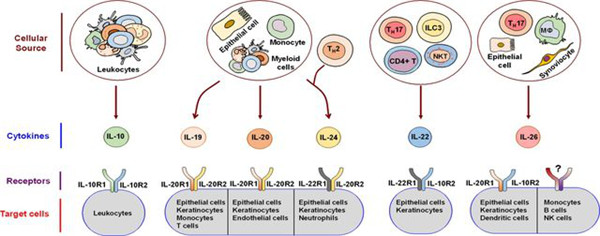Interleukins - the communications arm of the immune response
Product Manager:Harrison Michael

The Interleukin (IL) family is a group of cytokines and development factors mainly derived from white blood cells, which play a key role in coordinating the immune response.

Figure 1: Interleukin immunomodulatory pathways
Member of the interleukin family
Interleukin-1β (IL-1β) is a key mediator, which is mainly released by stimulated macrophages and monocytes. Its effects involve inflammation regulation, immune response regulation, and potential antitumor immune activation. Recent studies have found that it has the ability to stimulate T cell proliferation and induce IL-2 secretion, which further emphasizes its significance in immune regulation.

Figure 2: Structure of IL-1α
IL-2, as a T-cell development factor, plays an important role in maintaining the long-term development of activated T cells. In addition, it coordinates the activation and proliferation of natural killer (NK) cells and promotes the induction of interferon-γ (IFN-γ) and secretion of B cell development factors. The synergy between IL-2 and other interleukins, particularly IL-3, amplifies T-cell development and triggers IgG secretion by activated B cells, demonstrating the complex interplay within the immune system.
In addition, IL-4, which is mainly produced by T cells, acts as an important regulator to stimulate the development and differentiation of immunocompetent cells and enhance the function of T helper cells (Th2). Similarly, IL-5 is a hematopoietic cytokine with a key role in eosinophil proliferation, differentiation, and survival, as well as in immune regulation and antibody production.
Among the IL family members, IL-6 has multiple functions, regulating the acute-phase immune response to infection and injury, highlighting its dynamic role in immune homeostasis. In addition, IL-7 acts as a key lymphocyte development factor promoting the proliferation of pre-B cells, pre-B cells, and early T cells, as well as certain leukemia-and lymphoma-suggesting a broader significance in hematopoietic diseases.

Figure 3: Structure of IL-6
Produced by Th2 cells, B cells, macrophages, and keratinocytes, IL-10 is a key regulator of inflammation and exerts anti-inflammatory effects by inhibiting the synthesis of cytokines at the level of mRNA transcription or translation. However, its dual properties extend to enhance B cell function and cytotoxic T cell activity, emphasizing its subtle role in immune regulation.
In addition, IL-12, which is mainly derived from monocytes and NK cells, acts as an important inducer, stimulates IFN-γ production by T cells and NK cells, and has significant antiangiogenic properties, indicating its potential significance in the treatment of angiopoiesis-related diseases.
IL-13 is primarily derived from Th2 cells and plays a key role in B cell proliferation and differentiation, further emphasizing the complexity and versatility of the IL family.
Finally, as a cytokine produced by macrophages and T cells, IL-15 plays an integral role in immune homeostasis and immune responses by playing a key regulatory role in promoting T cell proliferation and maintaining the survival of CD8(+) cytotoxic T cells.
In summary, the interleukin family represents a complex network of cytokines and development factors, each with unique roles and interdependencies, orchestrating the immune response and offering promise for therapeutic intervention in a variety of immune-related pathologies. Ongoing research efforts continue to reveal new insights into its mechanisms of action, further expanding our understanding of immune regulatory and therapeutic pathways.
Aladdin:https://www.aladdinsci.com/
